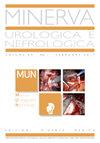Development and validation of a simple stone score (SSS) to estimate the probability of residual stones prior to percutaneous nephrolithotomy.
Q1 Medicine
引用次数: 2
Abstract
BACKGROUND The purpose is to develop and internally validate a simple stone score (SSS) to estimate the probability of clinically significant residual fragments (CSRF) prior to percutaneous nephrolithotomy (PNL). METHODS The files of 1170 PNL procedures between January and December 2015 were evaluated. CT-derived stone characteristics were examined. Caliceal stone distribution (CSD) was assigned three grades based on the number of calices involved regardless of the renal pelvis (I: no or single calix; II: more than one calix; III: more than 2 calices or complete staghorn stones). CSRF was defined as any residuals >4 mm in postoperative CT. A logistic regression model to predict the CSRF was fitted and coefficients were used to develop the SSS. The SSS was validated by discrimination, calibration, and decision curve analysis (DCA). RESULTS Patients' data were split into training (936, 80%) and validating (234, 20%) datasets. In the training partition, independent predictors of CSRF were CSD-grade II (OR: 4.2; 95%CI: 2.5-7; p<0.001), grade III (OR: 7.8; 95%CI: 4.2-14.4; p<0.001) and largest stone diameter (LSD) (OR:1.3; 95%CI: 1.1-1.6; p<0.001). Score points 0, 1, 2, and 0, 3, 9 were given to LSD <30, 30- 40, >40 mm, and CSD grades I, II, III, respectively. Discrimination of the SSS was 0.79 and after 10-fold cross-validation and internal validation was 0.86. The calibration plot and DCA highlighted the validity and clinical significance of the SSS. CONCLUSIONS The novel SSS could be used to describe the risk of CSRF prior to PNL. Further studies are invited for external validation.简单结石评分(SSS)的发展和验证,以估计经皮肾镜取石术前残留结石的可能性。
目的是开发并内部验证一个简单的结石评分(SSS),以估计经皮肾镜取石术(PNL)前临床显著残留碎片(CSRF)的概率。方法对2015年1 - 12月1170例PNL手术文件进行评价。检查了ct衍生的结石特征。肾盏结石分布(CSD)根据受累肾盏的数量分为三个等级,与肾盂无关(I:无肾盏或单肾盏;II:多于一个杯形;III:超过2颗或完整的鹿角石)。CSRF定义为术后CT上任何大于4mm的残差。拟合了一个预测CSRF的逻辑回归模型,并用系数来发展SSS。通过判别、校准和决策曲线分析(DCA)对SSS进行了验证。结果患者数据分为训练数据集(936,80 %)和验证数据集(234,20 %)。在训练分区,CSRF的独立预测因子为CSD-grade II (OR: 4.2;95%置信区间:2.5 7;p40 mm, CSD等级分别为I、II、III。经10倍交叉验证和内部验证,SSS的鉴别率为0.79,鉴别率为0.86。校正图和DCA突出了SSS的有效性和临床意义。结论新的SSS可用于描述PNL前CSRF的风险。邀请进一步的研究进行外部验证。
本文章由计算机程序翻译,如有差异,请以英文原文为准。
求助全文
约1分钟内获得全文
求助全文
来源期刊

Minerva Urologica E Nefrologica
UROLOGY & NEPHROLOGY-
CiteScore
5.50
自引率
0.00%
发文量
0
审稿时长
>12 weeks
期刊介绍:
The journal Minerva Urologica e Nefrologica publishes scientific papers on nephrology and urology. Manuscripts may be submitted in the form of Minerva opinion editorials, editorial comments, original articles, video illustrated articles, review articles and letters to the Editor.
 求助内容:
求助内容: 应助结果提醒方式:
应助结果提醒方式:


